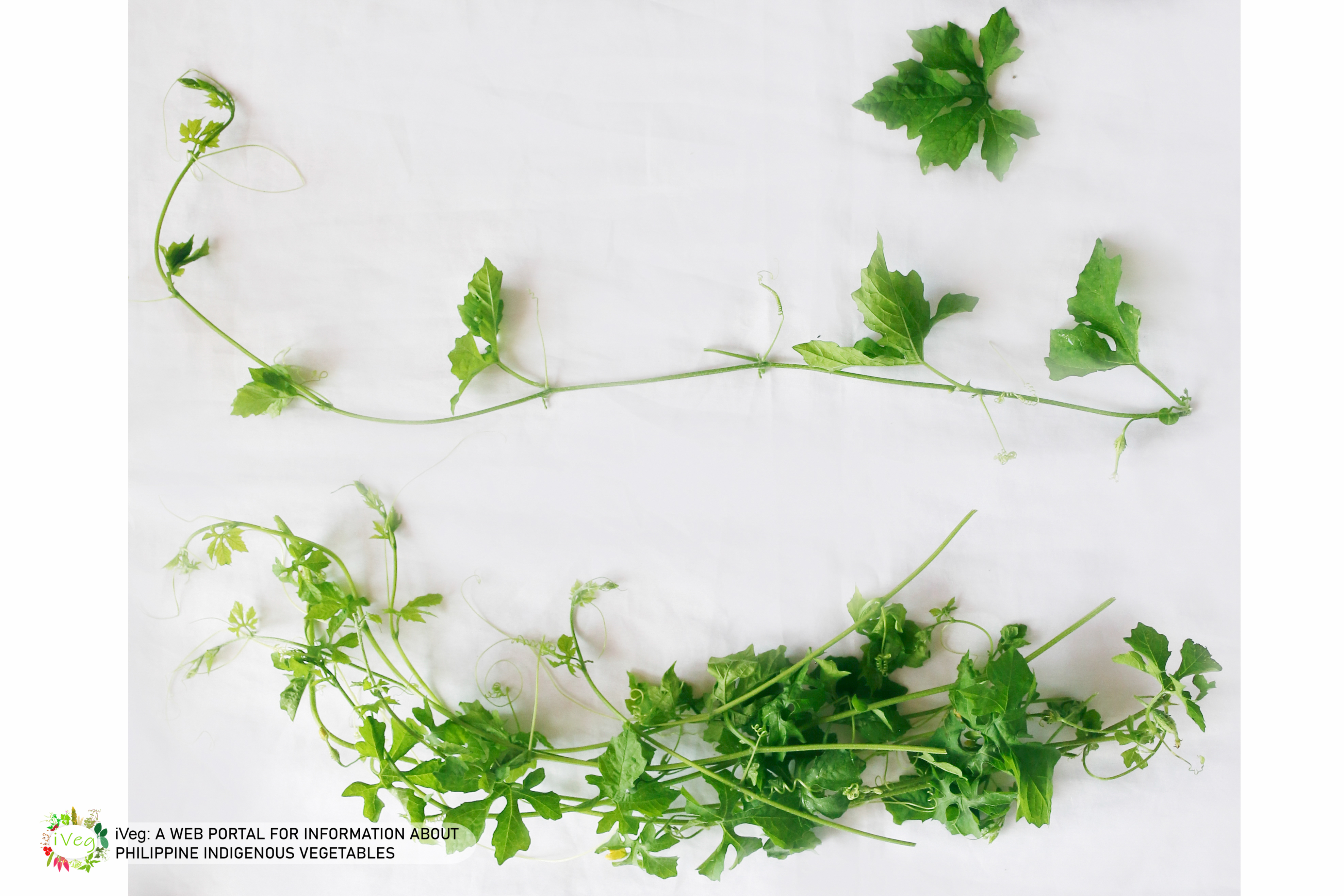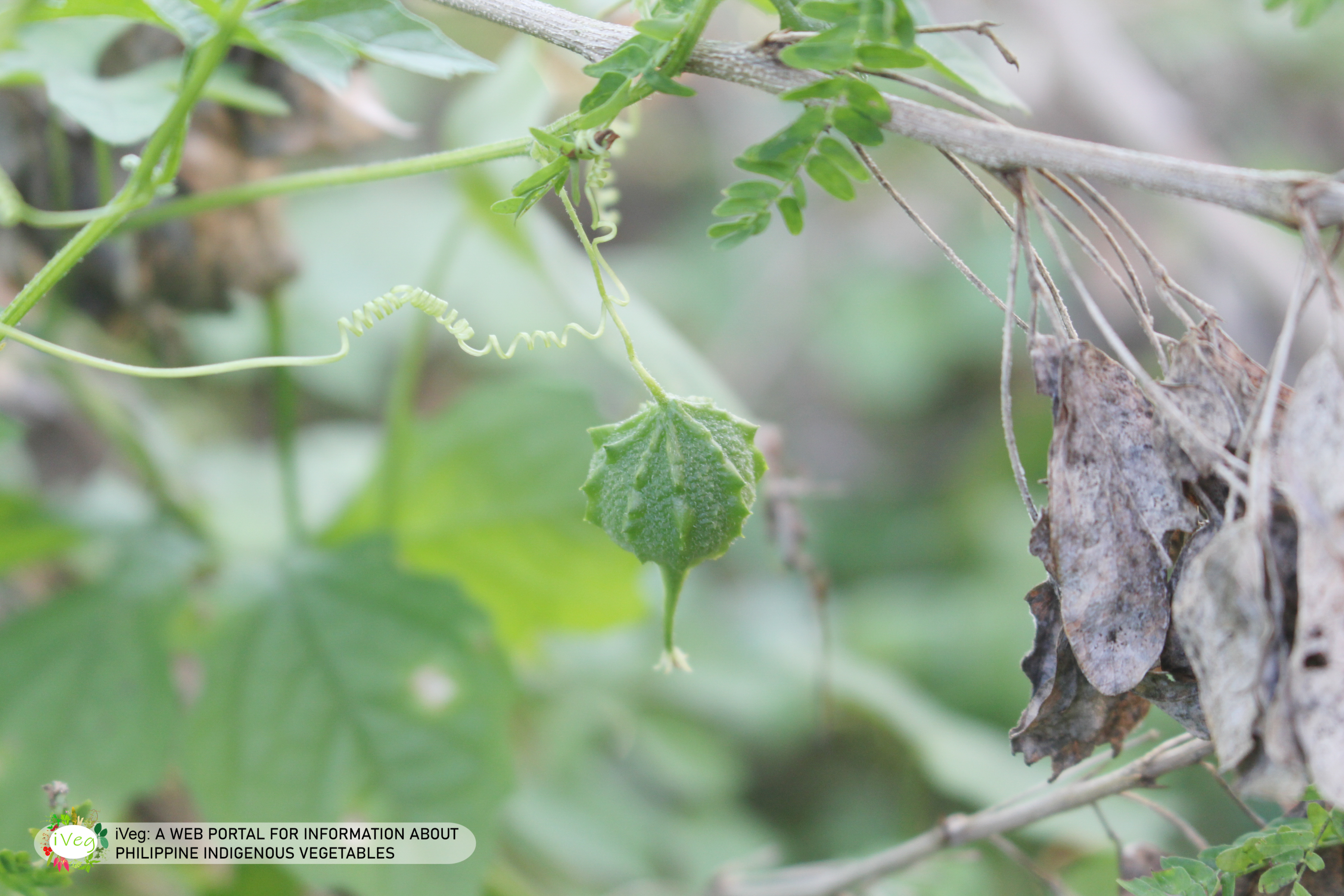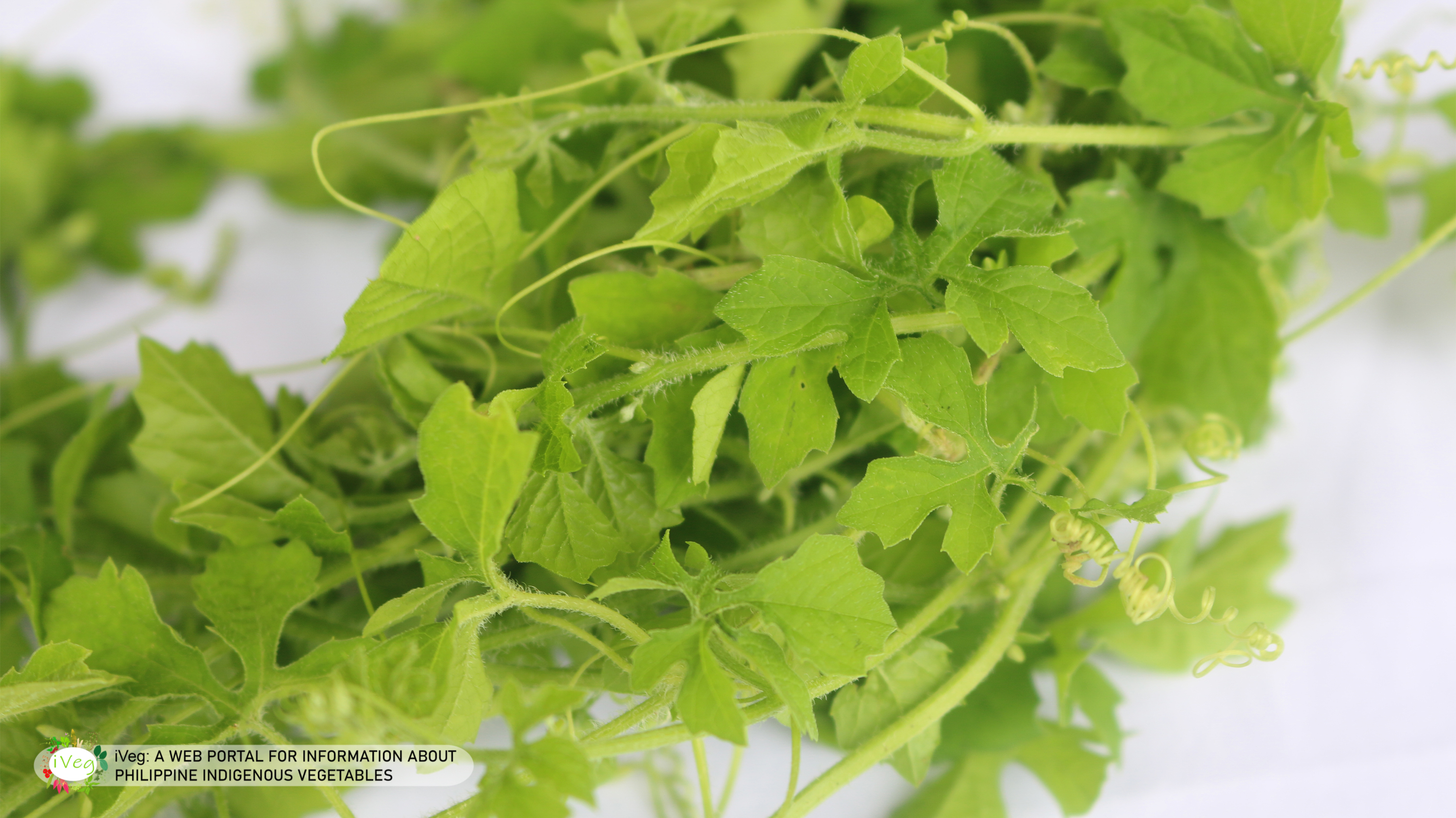Ampalaya/Bitter gourd
Momordica charantia L.
Family:
Cucurbitaceae
Synonyms:
Cucumis argyi
Cucumis intermedius
Momordica charantia subsp. abbreviata
Momordica charantia (f.) abbreviata
Momordica charantia var. abbreviata
Momordica charantia (var.) longirostrata
Philippine local names:
English Name: Bitter gourd
Botanical Description
Ampalaya (Momordica charantia), from the family Cucurbitaceae, is an annual to perennial monoecious climbing herb that is widely grown for its edible shoots, flowers and fruit. Its well-branched slender, ridged, green stems grow up to 5 meters. Leaves, with 1-7 cm long petioles, are 5-10 cm in diameter, rounded in outline, and have 5 to 9 toothed lobes. Its pale to deep yellow flowers grow up to 3 cm in diameter. Pendulous fruits are ribbed, wrinkled, and have distinct prickles, spines and warts. Fruit shapes vary between globular to cylindical tapering at each end, while sizes range from 3 to 25 cm long and 2 to 9 cm wide. Each of the flattened oblong seeds is 5 to 13 mm long, corrugated on the margins, and has finely pitted surfaces.
Conservation Status
Traditional cultivars of bitter gourd are on the verge of extinction as they are being replaced by commercial, improved varieties. Continuous habitat degradation and expansive land conversion have also threatened populations of wild varieties. To conserve these bitter gourd genetic resources, germplasm materials are kept in several genebanks and research institutes across the globe. In the Philippines, more than 100 accessions of bitter gourd are being conserved at the National Plant Genetic Resources Laboratory (NPGRL) in the University of the Philippines, Los Banos.
Agroclimatic/Edaphic adaption/Ecology
Ampalaya can be cultivated in various environments and soils but grows best in tropical or subtropical climates, from sea level to 1000 meter above sea level and with a temperature between 12.50C to 250C and mean annual rainfall of 480-4100 mm. Soil is preferably deep well-drained sandy loam or silty loam with rich organic matter and a pH level ranging from 4.3 to 8.7. In the Philippines, cultivated varieties are grown all throughout the year. Wild varieties of ampalaya, on the other hand, grow in thickets and waste places
Geographical Distribution
Ampalaya is widely distributed throughout tropical and subtropical regions on all continents. It appears to be native to the African and Australian continents, but its actual origin has been obscured by its spread as a food crop. Currently it can be found cultivated and naturalized in North, Central and South America, the West Indies and on several islands in the Pacific Ocean. The wild forms of ampalaya are distributed in tropical and subtropical Africa, Asia (Thailand, Indonesia (Sumatra, Java, Borneo), Malesia, Vietnam, Laos, Cambodia, Myanmar, Sri Lanka, parts of China (Yunan), Nepal), Malesia, Australia and Pacific, India-Andaman and Nicobar Islands, and South, North Himalayas. The original place of domestication of Ampalaya is unknown or unclear for want of credible archaeological evidences. The putative areas for domestication proposed by various workers include southern China, eastern India or eastern Asia (Walters and Decker-Walters, 1988 as cited in Rojas-Sandoval and Avecedo-Rodriguez, 2018).
Marketing
Tablets from leaves are now available.
Conservation Practices
Traditional cultivars of bitter gourd are on the verge of extinction as they are being replaced by commercial, improved varieties. Continuous habitat degradation and expansive land conversion have also threatened populations of wild varieties. To conserve these bitter gourd genetic resources, germplasm materials are kept in several genebanks and research institutes across the globe. In the Philippines, more than 100 accessions of bitter gourd are being conserved at the National Plant Genetic Resources Laboratory (NPGRL) in the University of the Philippines, Los Banos.
Part utilized as vegetables
Leaves, fruits,flowers
Uses
Food/ Edibility/ Culinary
Bitter gourd (Ampalaya) could be eaten uncooked- slice into thin strips then mash it with salt to remove bitterness. Mix with chopped tomatoes and onion. (Mabesa et al) Btter gourd (ampalaya) fruits eaten as slightly boiled or steamed - cut the fruits longitudinally, romove the seeds, scrape off the whitish part in the hollow portion until the green part can be seen. Slice the fruit thinly then mash with rock salt to remove the bitter taste. Squeeze. Throw away the juice that comes out. Alternatively soak in salted water for 30 minutes to an hour. Wash and cook. Light green fruits are generally less bitter than the dark green ones. In general, the longer it is stored, the more bitter it becomes. (Mabesa et al)Medicinal
The extract juice from ampalaya leaves is used to treat coughs; the liquid from coiled leaves also expels intestinal worms and helps cure open wounds. It is an effective cure for diabetes and skin infections, and is applied eternally for hemorrhoids. (Dolera et al) Leaf juice is used for cough; parasiticide; vulnerary. Juice expressed from the green fruit is remedy for colitis and bacillary dysentery. The whole plant is used for the treatment of diabetes, emetic, for skin diseases, sterility in women, for chronic ulcers of the stomach. Root decoration is abortifacient; powedered roo, fruit or seed are used as ingredient in aphrodisiac preparations, applied externally to hemorrhoids, has atringent properties. (de Padua et al, 1977) Wash and chop the roots, fruits and seeds. Extract the juice and mix with oil. Use 1/2 cup chopped roots, fruits and seeds with 2 tablespoons of oil. Wet cotton with the ampalaya-oil mixture and apply on the hemorrhoids after the hot sitz bath. (de Guzman-Ladion, H. (n.d). Healing Wonders of Herbs) Used as food, medicine and also used in the treatment of skin diseases, sterility in women, as a parasiticide, antipyretic and as a purgative. (Garcia) Fruits, young shoots and flowers are used as flavoring the leaves as leafy vegetable and the pulpy arils as sweets. Ampalayang ligaw may be canned, pickled or dehydrated. To reduce the bitter taste, the fruits can be blanched or soaked in salt water before cooking. Ampalayang ligaw has been recommended by the Department of Health (DOH) as one of the best herbal supplements to prevent liver problems, diabetes and HIV. It is also used to treat skin disease and sterility in women, as parasiticide, antipyretic and purgatic. There are also reports that the seed extracts induce abortion. (DA-RFO 2)
Correct Citation
Documentation of Indigenous Vegetables (2020) Retrieved from www.iveg.com.
See references:
Galvez Tan, J. Z. & Sia, I. (2014). The Best 100 Philippine Medicinal Plants PCAARRD- DOST. (2000). Vegetable Planting Calendar.Dolera, N., Florento, C., Lichauco, M., & Tarriela, F. (n.d). Oops dont throw those weeds away de Padua, L.S., Lugod, G.C., & Pancho, J.V. (1977). Handbook on Philippine medicinal plants volume 1. University of the Philippines, Los Banos.
DA-RFO 2. Indigenous Vegetables Production Guide (n.d). Department of Agriculture Regional Field Office no. 2. High Value Crops Development Program.
Mabesa, R. C., Bautista, O. K., & Aquino, A. T. (n.d). Growing Vegetables and other Edibles in Containers. Philippine Seed Industry Association under the HVCCP-DA. UP Main Library National Nutrition Counci. (n.d). Pagkain sa Bawa't Mesa.
Rummel D. J. (n.d.). Philippine Medicinal Plants in Primary Health Care Vol 1. Quezon City, Philippines: C&E Publishing, Inc.
Garcia, J. T. Culture and Utilization of Selected Indigenous Vegetables and Menus Generated Using Indigenous Vegetables in Selecte Regions in the Phiippines. Buraeu of Plant Industry Rojas-Sandoval, J. & Avecedo-Rodriguez, P. (2018). Momordica charantia (Bitter gourd).
https://www.cabi.org/isc/datasheet/34678#d7d305c3-5e7f-47f1-b889-bdbefa5ed2ce
















Properties
Food Composition per 100g Edible Portion | Unit | Bitter melon fruit, raw | Bitter melon/gourd fruit, boiled | Bitter melon leaves, raw | Bitter melon/gourd leaves, boiled | ||
|---|---|---|---|---|---|---|---|
| Water
Energy, calculated Energy, calculated Protein Total Fat Carbohydrate, total Carbohydrate, available Ash, total |
g
kcal kJ g g g g g |
93.9 23 95 1 0.2 4.2 2.9 0.7 |
95.3 19 78 0.4 0.2 3.8 2.2 0.3 |
90.6 34 143 4.2 0.6 3 0 1.6 |
87.6 50 210 2.2 0.6 9 6.9 0.6 |
courtesy of Food and Nutrition Research Institute Department of Science and Technology




